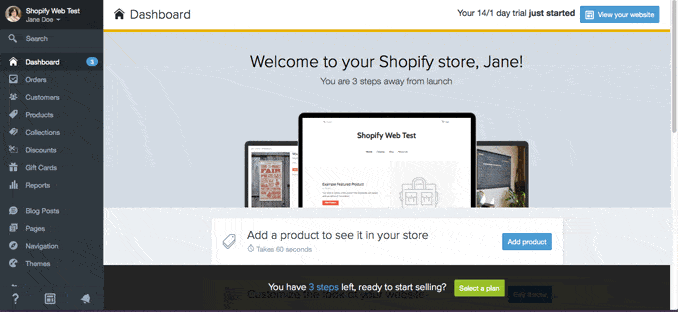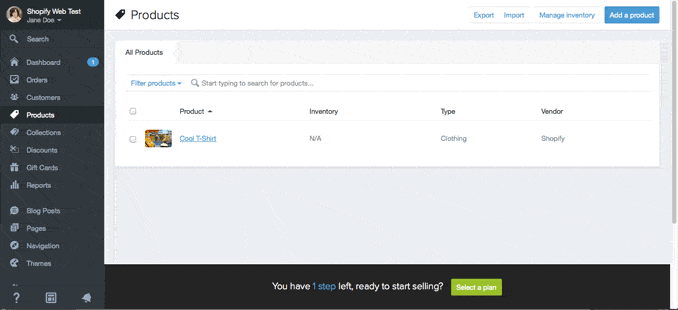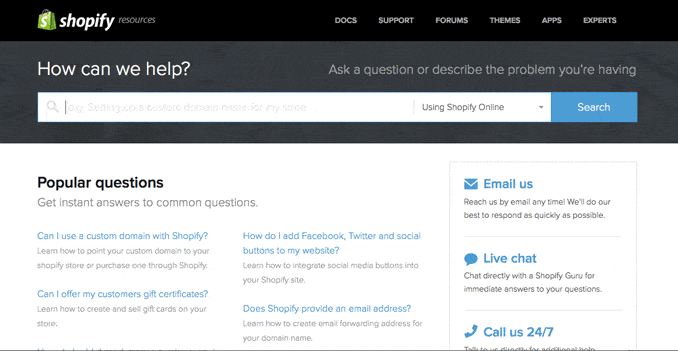Contents
Shopify Review: An Advanced Storefront For Businesses Serious About Selling Online
In case the name doesn’t clue you in, Shopify is a web builder designed for online stores. While you can toss a blog in there or a static page or two, the web store is obviously the focus of this platform—making it a good match for businesses also just as serious about selling products online. But a quick glance over the price list appears to be a bit higher than many other options—does the wide range of shopping features fit the bill?
Getting Started with Shopify
Shopify offers a 14-day free trial to test out the platform before you make a purchase. Sign up is easy, though it does require a valid address and a phone number.
Once you are logged in, you’re taken straight to the dashboard with a list of three steps to get your site live: Add products, customize your look and setup the domain. In reality, if you only take those three steps, you’ll end up with a live home and about page and a blog that has text instructing you how to set up those pages, so there’s a little more to it than that. The navigation bar at the left-hand side keeps all the editing options organized, however, so with a little exploration, it’s easy to complete the first few steps to getting the site started.
Adding Products to Shopify
Shopify is focused on selling products (or digital goods) online, and that’s easy to see with all of the shopping and product options available. Starting by clicking “products” on the lefthand side (or by clicking the first task listed in the initial dashboard), you are taken to a searchable inventory list, with the option to add products at the top right. Adding a product is pretty straightforward—the page has multiple options to fill out, but many of them can be left blank. There is, of course, the product title, then the description, where you can add more than just simple text—you can supplement with images, tables, video or even HTML code. Compared to the other platforms we’ve reviewed so far, Shopify seems to have the most options for a product, from basic information like weight and SKU to organizing tools like tags and collections. Shop owners can even customize what shows up in the search results; search engine optimization fields are filled in automatically based on the title and description but can be easily changed. Overall, adding a new product was pretty straightforward, and despite all the options, didn’t take horribly long either. But outside of product options, there are quite a few storefront features worth taking a look at (some of these features are limited based on what package you purchase).
Shipping options can be set based on weight or order price, and adjusted based on regions. Taxes can already include in the item price or added separately. Coupon codes, either as a percentage or a dollar amount, are extremely easy to set up. Gift cards can be operated right within the platform too if you choose one of the larger plans, as well as reports and analytics that show where your web traffic is coming from and what areas your customers live in.
Customizing the Design & Adding Pages to Shopify
Shopify sites are based on design templates, making it easy to set-up. There’s a variety of templates available (over 100), some free and some paid, ranging in style from minimalist to magazine-style sites with full-page images. Customization varies based on the theme, but most appear to have quite a wide range of options, including adding your own logo, changing colors or fonts and adjusting the layout.
Shopify automatically adds a home page, an about page and a blog to the initial site. The blog can be deleted if you don’t want one—though it took me a few minutes to find out just how to do that. With the platform being focused on an online store, it would make more sense to have the blog option available to add. Instead, users who want just a basic store have to go in and delete the blog. The About Us page can also be deleted, or simply unpublished to work on at a later time. What gets a little confusing is that the home page options aren’t exactly all in the same place. The page option in the navigation bar allows you to change text, add images or video and adjust search engine optimization options. This is where the text is added to the homepage. To get the graphics to coincide with the template you selected, however, you have to upload the images to the Theme settings. Not a big issue once you’ve done it once, but it may be a stumbling block for inexperienced users.
Help & Support from Shopify
At the bottom of the navigation sidebar in the admin panel, a question mark icon takes you to the help center and a variety of articles and frequently asked questions. If you still can’t find the answer you are looking for, there are three options: A phone number, a live chat, or email. I sent the Shopify help team an email—I got a response two hours later that answered my question well and provided links to additional resources.
Shopify Review: Final Verdict
As a platform designed specifically for selling online, Shopify seems to have everything store owners would need and then some. They seem to have more features and options, at least in the way of e-commerce, than the typical web builder. Of course, with more features, there’s more to navigate in the administrative panel, which could be a little more intimidating for newbies than a platform with only a few basic options. All of those extra options seem to come at a slightly higher price, though certainly not exorbitantly so until the large corporate rates. For just starting out, $14 gets you the bare minimum, limited to 25 products in the store.
The $29/month basic option allows for unlimited products, though no gift cards or analytics, while the $79 and $179 continue to beef up on big features for big businesses. You can also purchase a .com domain name for $9 a year, or upload one purchased from another source. Apps that further expand the site’s capabilities, like adding pop-ups or product reviews, are extra, though a handful are free. With all the wide expanse of features, Shopify is certainly a web builder that business owners focused on selling online should consider.



